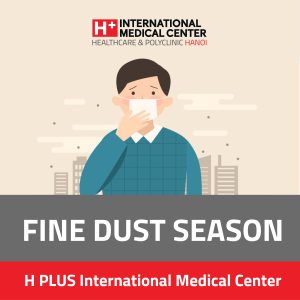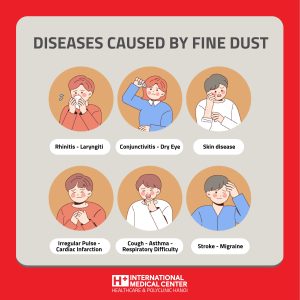As spring comes, the weather gets warmer and fine dust, ultrafine dust, and yellow dust from China come with it, causing respiratory diseases.
The risk is high, so you need to be careful. Due to the harmful dust, which are the main causes of air pollution, it can cause bronchitis, asthma, and allergic rhinitis.
It can cause various diseases, including chronic obstructive pulmonary disease and cardiovascular disease.
What is fine dust?
Fine dust is a particle size of 10μm or less, causing inflammation in the human alveoli, and as inflammation is repeated, it causes deterioration, aging, weakening of lung function and chronic lung disease. Ultrafine dust is a fine dust of 2.5μm or less. These two types of dust, whose particles are hard to filter, enter the respiratory tract and body and accumulate in the lungs and blood vessels. It directly impacts the organs and tissues in the body and causes an inflammatory response.
It causes many diseases by aging, affecting respiratory diseases, cardiovascular disease, and even the brain.
Heavy metals in fine dust contain harmful substances such as iron and cadmium, which penetrate the lungs through the respiratory system and cause cardiovascular disease. It can cause, if the intake of fine dust or ultrafine dust is prolonged, chronic and various diseases, it increases the risk, so you need to be especially careful.
Causes of fine dust
Fine dust is an air pollutant that causes various diseases and is a very fine and small dust particle that is invisible to our eyes.
These are pollutants generated from automobile exhaust fumes and industrial processes.
Once fine dust enters the body, it remains there and is not expelled from the body.
Ultrafine dust is also produced in cooking fumes, which are smoke generated when cooking food, such as grilling fish or meat.
Diseases caused by fine dust
Fine dust accumulated in the bronchial tubes or lungs irritates the nasal and respiratory mucosa, causing or worsening rhinitis, otitis media, laryngitis, bronchitis and asthma. It also causes various diseases such as cancer, high blood pressure, arrhythmia, arteriosclerosis, thrombosis, intestinal obstruction, dry eye, and allergies.
March is the month with the highest average concentration of ultrafine dust per year, and we must pay extra attention as the World Health Organization has designated ultrafine dust as a cause of lung cancer and bladder cancer and designated it as a Group 1 carcinogen.
Fine Dust Prevention
The best way to minimize the damage caused by fine dust is to limit exposure.
Pregnant women, infants, children, elderly people with underlying diseases, and people with chronic diseases are in the high-risk group and must refrain from going out. If you must go out, we recommend wearing a KF80 or higher health mask.
When you return home after going out, shake off the soles of your shoes and clothes, go inside, and wash your face, hands, and feet thoroughly.
You should be thorough in managing your personal hygiene. After going out, brush your teeth and if you have a sore throat, gargling also helps.
Indoors, ventilate for 5 to 10 minutes every hour to reduce the concentration of fine dust indoors. When using an air purifier, it is also necessary to check the filter in advance. It is best to keep the indoor humidity at 40–60% and the temperature at 20–22 degrees so that it is not dry. People with underlying diseases are at greater risk than the general public, so they should be more careful. When going out, take your usual medications and symptom relievers. You should carry emergency medicine. In addition, you should avoid foods, exercise regularly, and manage stress. Building your immunity through healthy lifestyle habits also helps.
 +84 24-7306-9889
+84 24-7306-9889  Booking
Booking 





